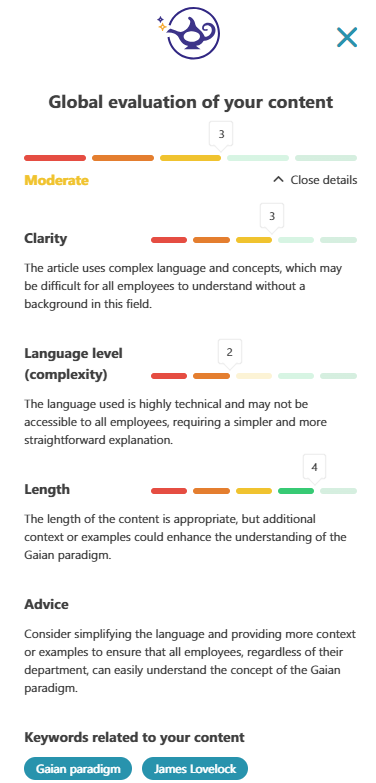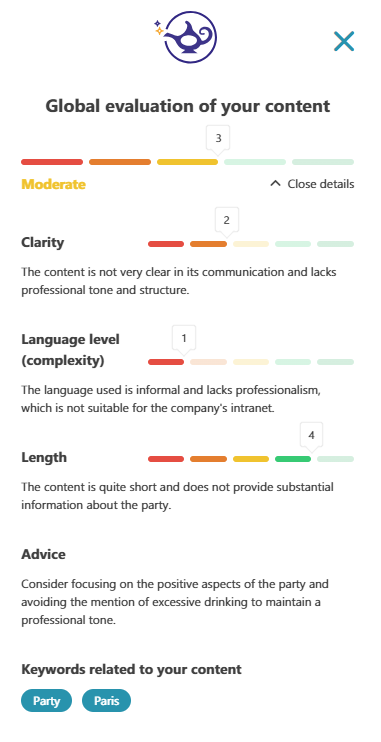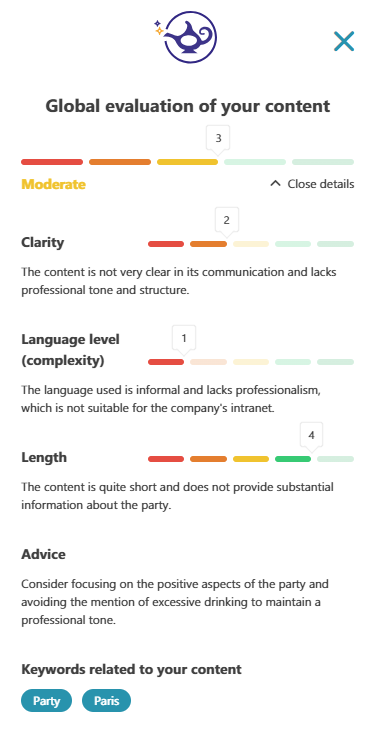The pillars of quality content: Substance and style
High-quality intranet content is defined by its substance and style. Substance refers to the depth and relevance of the information presented, ensuring it is accurate, comprehensive, and beneficial to the intended audience. Style encompasses the manner of presentation, including the tone, readability, and format of the content.
To achieve this quality, let’s break down substance and style into some key elements:
- Clarity and simplicity: The content should be clear and straightforward, avoiding jargon and overly complex language that can confuse readers.
- Engaging and relevant: Articles and updates should be interesting and address employees’ interests and needs. Including stories, examples, and visual aids can enhance engagement.
- Consistency and professionalism: Maintaining a consistent tone and style across all content ensures professionalism and helps build a cohesive organizational voice.
Challenges for intranet contributors
Expertise vs. accessibility
One of the main challenges is balancing expertise with accessibility. Domain experts often use technical jargon that may not be easily understood by all employees. Conversely, content written by non-experts might lack depth and accuracy.
Varied writing styles
Employees from different departments and backgrounds contribute to the intranet, leading to varied writing styles. A site manager might use a casual tone, while someone from the central office might produce overly lengthy and formal texts. These inconsistencies can lead to information overload for employees, making it difficult to find the specific information they need.
Language barriers
Language barriers pose significant challenges in multinational organizations. A contributor might be good at writing high-quality content in their native language but struggle to replicate the same quality in another language, impacting the content’s reach and effectiveness.
Impact of poor-quality content
Poor-quality content can have far-reaching negative impacts on the organization:
Low engagement
Employees are less likely to engage with unclear, irrelevant, or overly complex content, which leads to lower interaction rates and missed opportunities for collaboration.
Information gaps
Critical information might not be effectively communicated, leading to misunderstandings and inefficiencies.
Erosion of trust
Consistently poor-quality content can erode trust in the intranet as a reliable source of information, leading employees to seek information elsewhere.
Solutions for enhancing content quality
Internal and external reviewers
Traditionally, maintaining quality on the intranet relied on human expertise. Internal reviewers or external writers could ensure clarity and accuracy, especially for critical articles. But let’s face it: This approach has limitations. Extended timelines and high costs make it impractical to maintain a constant stream of content on a busy intranet.
A built-in AI assistant
The good news is there’s a smarter way. Artificial intelligence (AI) in internal communications is poised to transform your intranet experience. Imagine having a built-in editor, like Powell Intranets AI assistant, that empowers you to create high-quality content every time.
- Automated quality scoring: Integrated AI automatically evaluates the quality of content, providing scores based on complexity, clarity, and length. This ensures that all content meets predefined quality standards.
- Content enhancement: The assistant offers suggestions for improving the text, including simplifying complex language, optimizing length, and adjusting the tone to match the organization’s style guidelines. This is particularly useful for occasional contributors who may not be familiar with best practices in content creation.
- Multilingual capabilities: Powells AI intranet can assist with translating and adapting content for different languages, ensuring consistency and quality across the organization’s global workforce.
- Guided content creation: The built-in generative AI tool can generate drafts based on user instructions, helping contributors who may struggle with starting from scratch. This feature ensures that all content adheres to organizational standards from the outset.
Impact of high-quality content
Writing high-quality content for the intranet is essential for maintaining employee engagement, effective communication, and a cohesive organizational culture. While challenges such as varied writing styles, expertise levels, and language barriers exist, AI tools like Powell Intranets Assistant provide practical solutions to overcome these hurdles.
By automating quality checks, offering content improvement suggestions, and facilitating multilingual content creation, Powell Intranet ensures that intranet content remains professional, engaging, and accessible to all employees. This not only enhances the overall user experience but also strengthens the intranet as a vital tool for internal communication and collaboration.
Once you’ve mastered the basics of high-quality content creation, you can explore strategies to improve intranet content management and keep your audience engaged. Look for opportunities to generate fresh intranet content ideas, like employee spotlights, department Q&A sessions, or fun polls.
Examples of AI-assisted intranet content creation
To showcase the power of AI in tackling common intranet content challenges, we tested Powell Intranets content improvement features on two pieces of content with contrasting issues:
Text 1: Excessive complexity
Gaia (800 words) The Gaian paradigm, a concept developed by James Lovelock and co-developed by Lynn Margulis, postulates cybernetic feedback where the Earth’s biocenosis and abiotic elements collaborate symbiotically to maintain conditions conducive to life. This assumption, often described as organic and holistic, transcends traditional reductionist approaches. Gaia, an autopoietic entity, intrinsically regulates physicochemical parameters such as temperature and atmospheric composition through biogeochemical feedback mechanisms…
This text is filled with technical jargon and complex concepts that can be difficult for the average employee to understand, illustrating the challenge of over-complexity in intranet content.
Text 2: Colloquial language and errors
Festive Event (300 words) The other night, there was a big party in Paris and it was super cool. We danced all night and everyone had a great time. The organizers had planned tons of awesome stuff, like games, delicious food, and a DJ who set the place on fire. Honestly, it was an unforgettable night, even though some people were a bit too drunk. Personally, I loved every moment, even when I almost fell over while dancing…
This text uses informal language and a casual tone, which can be too familiar for a professional executive, showing the opposite problem of too much familiarity and lack of professionalism.
Conclusion
Fostering a culture of high-quality intranet content creation empowers your organization in several ways. It boosts employee engagement by ensuring information is clear, relevant, and interesting. This, in turn, strengthens communication and collaboration across departments.
However, maintaining this level of quality can be challenging.
An integrated AI assistant like Powell Intranets offers a powerful solution. Imagine having a built-in editor that streamlines the process and empowers every contributor to consistently produce professional content.
Powell Intranets AI capabilities tackle various challenges by offering features like automated quality scoring, content enhancement suggestions, and multilingual capabilities. This ensures consistency, clarity, and accessibility for a truly global workforce.
By leveraging AI, you can transform your intranet into a dynamic and informative hub that fosters a thriving organizational culture.









